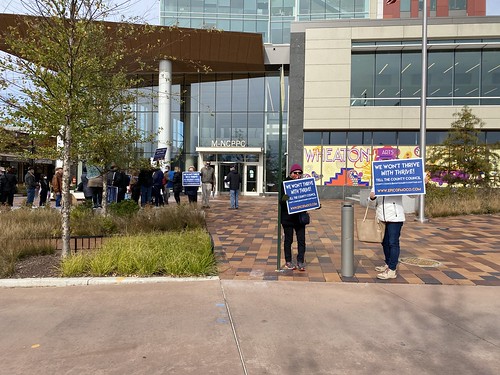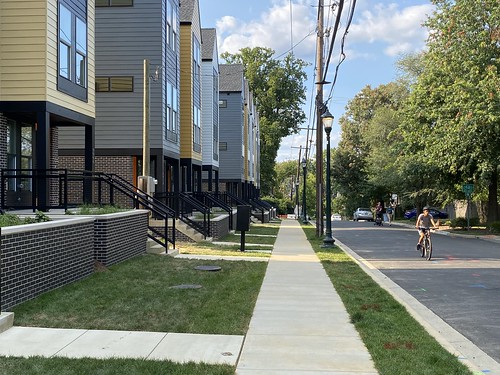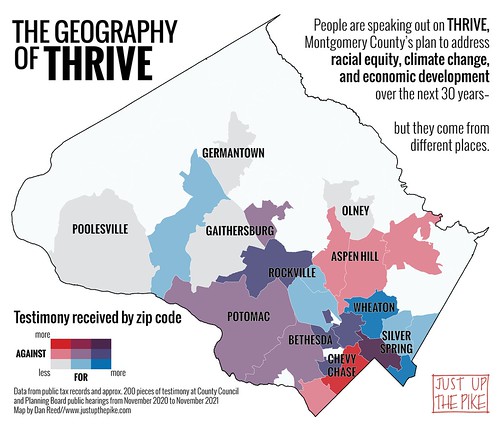Montgomery County council members are currently reviewing Thrive 2050, a “plan for other plans” that will guide zoning and policy decisions in the coming years. It updates the county’s General Plan, first written in 1964, and tackles some of the big issues of our time: climate change, segregated neighborhoods and schools, skyrocketing home prices, and a sluggish economy.
 |
| Protesters opposing the Thrive 2050 plan in November 2021. Photo by the author. |
Council members may finally pass Thrive, even as a group of residents tries to stall or block it, arguing that there hasn’t been enough community input. It appears, however, that opponents want more say for themselves — not the increasingly diverse residents who need to be heard the most.
Of Thrive’s recommendations, one that’s gotten the most attention is allowing more affordable duplexes, townhomes, and apartments in areas where you can only build a single-family house.
 |
| New townhomes near downtown Silver Spring. Image by the author. |
Thrive doesn’t change zoning, but it would empower the county to allow more homes in areas near transit or major roads. The plan ties this to racial equity — noting that single-family zoning was created to keep Black people out of white, affluent neighborhoods and that today, wealthy neighborhoods use zoning to block more affordable homes. Planners also suggest that opening up these communities can address our chronic housing shortage, allow more people to walk, bike, or use transit instead of driving, and retain the county’s workforce as many people who work here can’t afford to live here.
Some residents who are upset about changes to single-family zoning say the plan still needs more public feedback. They’ve led a months-long campaign against the plan, leading up to a protest outside the Planning Department last month.
But in reality, county officials have been working on Thrive since 2018 and have held over 160 community meetings, many of which focus on people we don’t always hear from like immigrants, renters, and students.
As of December, there will have been five public hearings: one at the Planning Board in November 2020, two at the County Council in June 2021, and two more council hearings November 30 and December 15.
 |
| A geographic look at Thrive testimonies. Image by the author. |
A breakdown of supports and their opposition
Inspired by this project in Charlottesville, I looked at the speakers’ lists and testimony for Thrive’s first four hearings — including 200 statements from about 180 community members — and compared them to the public tax record. This way I could find out who, and where support and opposition come from.
The research showed that most of the testimony on Thrive came from people living inside the Beltway, which isn’t unusual as this area is known for being politically active. One area where both groups overlap is Zip code 20910 (close-in Silver Spring), which accounts for 24% of opponents and 41% of supporters.
Beyond that, opponents and supporters come from different places. Opponents are concentrated in the county’s southwest: nearly one-third of opponents live in Chevy Chase (zip code 20815), while 16% live in Bethesda (zip codes 20814, 20816, and 20817). There is also a pocket of opponents in the Aspen Hill area (zip codes 20853 and 20906).
Supporters clustered on the east side, which is historically more diverse and less affluent. Nine percent live in Takoma Park (zip code 20912), while 16% live in the outer parts of Silver Spring (zip codes 20901, 20902, 20903, and 20905). There’s also a concentration of supporters along the 270 corridor, with 11% from Rockville (zip codes 20850, 20851, and 20852).
Montgomery County's revised general plan, Thrive 2050, makes no direct changes to exclusionary restrictions but broadly proposes that we implement changes to make the county more welcoming and environmentally friendly.
— Gray Kimbrough (@graykimbrough) November 20, 2021
Opponents of this plan look very different from supporters. pic.twitter.com/IGe2XFP3yU
There’s also a distinction between the types of homes supporters and opponents live in. In their testimonies, many supporters said they rent, live in apartments or townhomes, or moved to the county more recently. Most opponents said they own single-family homes or have they have lived in the county for a long time.
Eighty-eight percent of opponents are in the public record, meaning they’re homeowners, and 81% own single-family homes. The average opponent’s home is assessed at $894,000. Sixty-three percent of opponents own homes valued for at least $540,000, the county’s median home price in October 2021, and 25% own homes worth over $1 million.
Meanwhile, just 57% of supporters own homes, and 49% own single-family homes, which more closely reflects the county’s housing stock: 65% of Montgomery County households own their homes, and 48% of homes are detached. The average supporter’s home is assessed at just $565,000, and 27% own homes valued over the county’s median home price of $540,000.
Opponents tend to have owned their homes for longer. 40% have owned their home for at least 20 years, and 19% for at least 30 years. Meanwhile, just 18% of supporters have owned their home longer than 20 years, and 14% bought a home within the past 5 years.
When people say more community input, they’re talking about themselves
Opponents have claimed that Thrive is the result of a broken process, but maybe it’s because they’re unhappy with the outcome. In the four hearings so far, most people who gave testimony spoke in favor or supported it with amendments. Organizations backing the plan range from social justice groups, environmental groups, affordable housing providers, and the county’s food council. Most council members said they support it as well.
Let’s be clear: Montgomery County, like most places, can always do more and better public outreach. But when opponents talk about who should give more input, they’re often talking about themselves. For DCist, Ally Schweitzer recently interviewed one resident, who says, “We won’t have any power anymore” if the county legalizes duplexes in his neighborhood, comparing it to voter suppression because he and his neighbors won’t be able to block them.
The Montgomery County Civic Federation, a group of neighborhood associations, wants to scrap the plan and restart the process with them as “equal participants” despite having met with Planning Board chair Casey Anderson about the plan four times going back to 2019. Their alternative: only changing zoning in places like Burtonsville or around Lakeforest Mall, both of which are less-affluent, majority-minority communities. It’s unclear if any of these communities are actually represented in MCCF’s membership.
County council president Tom Hucker notes that in a progressive place like Montgomery County, there should be buy-in for tackling racial equity and climate change. "If people read it, they will find it very non-controversial because it basically confirms what most people believe in,” he said on a recent episode of the Politics Hour.
Over the next several weeks, the council will review Thrive and have the opportunity to make edits. For now, no vote has been scheduled.

No comments:
Post a Comment